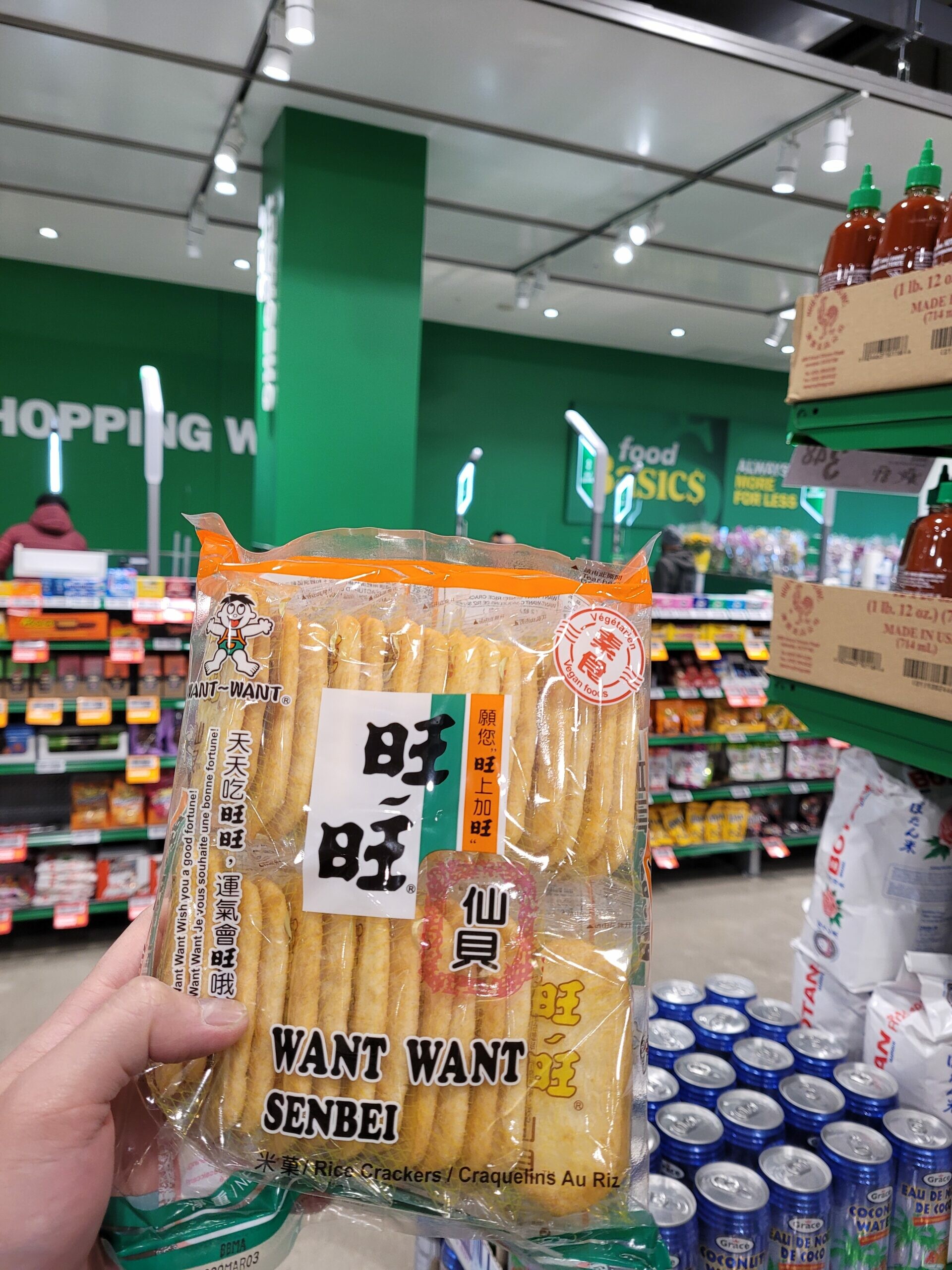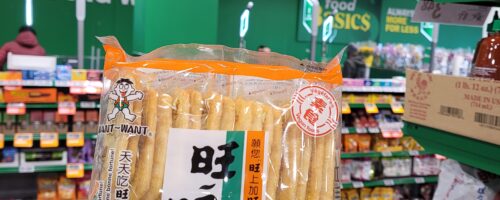
3 Xinyuan Road, Huangpu, Guangzhou, Guangdong Province, China
How is it produced?
Want Want rice cracker is a packaged rice cracker made from rice flour, which is kneaded and ground into kuih, the kuih is baked at high temperature, and in the final process, the manufacturer adds the seasoning powder to the finished product. (Want Want Food, 2021). This rice cracker was created by the food and beverage company called Want Want Group. Want Want Holdings is one of the biggest food and beverage companies in East Asia. It operates over 100 manufacturing plants in mainland China and 2 in Taiwan and employs over 60,000 people (Wang, 2008).
Although many factories have set up automatic rice cracker production lines, making the rice cracker still requires labour-intense works. The factory usually asks workers to work in rotating shifts, which means the factory can run 24 hours every day to produce the rice cracker for the customers.
The vast majority of food workers are incredibly low-wage, with little or no access to paid sick days and health benefits. Many workers reported earning sub-minimum, poverty, and low wages, resulting in a sad irony: food workers face higher levels of food insecurity, or the inability to afford to eat (Hays, 2014).
Describe the supply chain to the store shelf in Canada:
We can buy Want Want rice crackers from many Asian grocery supermarkets in Canada. We are also able to find many Want Want snacks from some mainstream supermarkets, such as Food Basics, No frills and Walmart. I usually buy Want Want rice crackers from Food Basics because their selling price is lower than other supermarkets. But Food Basics only has two or three flavours of Want Want rice cracker available. The Want Want rice cracker which I bought from Food Basics, is manufactured by Guangzhou Big Want Foods Ltd, which is located at Big Want Building, No.3, XinYuan Road, Yong He Economic Zone of Getdd, Guangzhou, China.
Big Want Foods Ltd is the authorized manufacturer to Want Want Holdings base on online research ( TÜV Rheinland, 2021). Most of Want Want rice crackers we see in the Canadian market are made from this factory. Other Want Want products sold in other markets may be from other authorized manufacturers in China or other countries. Want Want usually make rice cracker and other snacks through their original equipment manufacturers (OEM). OEMs produce a product and then sell that product to suppliers. They typically design products and create them using sellers’ preferences and specifications and have some freedom to innovate and design products(Foods, 2019), in this case, Want Want Holdings directs their OEMs to manufacturer the rice cracker according to their packaging design and special flavour. Want Want Holdings or Big Want Foods Ltd sell this specific rice cracker brand to Canadian suppliers or distributors, the suppliers then make the deal with major grocery companies to list Want Want rice cracker brands on the shelf. Want Want Holdings or distributors have done some market research already to promote this type of rice crackers to Canadian consumers.
The suppliers and distributors of Want Want rice crackers have to get a license from The Canadian Food Inspection Agency (CFIA) when they are importing the rice cracker to Canada. CFIA currently uses a range of tools and approaches for import control, based on its legislative and regulatory framework, to target inspection resources and to verify compliance with requirements, in line with international rights and obligations(CSCB National Office,2016).
What is the power balance between the producer and seller?
In regards to Want Want rice cracker, the producer of the rice cracker is the original equipment manufacturers. The seller and retailer are Want Want Holdings and other authorized distributors. Want Want Holdings and other distributors have much more power over the producers. Want Want Holdings can give their rice cracker orders to other factories, if one of the factories can not satisfy Want Want Holdings’ needs, such as increasing production lead time, lowering their production cost or making other labels for the new rice crackers. Other distributors also can make their requests to the factories, they can even negotiate the purchasing price with the factories if they shop around with other rice cracker factories.
Rice cracker is one of the common snacks in many Asian countries, we do not find any trade agreements related to rice cracker Intellectual Property Rights. Any people or legal entities can manufacture the rice cracker and register their rice cracker brand with the authority to mass-produce the rice cracker.
Can you recommend changes to the system to improve the balance?
The rice cracker manufacturers usually do not sell their rice crackers directly to the customers, Want Want Holdings and other distributors served as middlemen by purchasing rice crackers in bulk from the manufacturers and selling them to consumers at a higher rate. Want Want Holdings provides the manpower, infrastructure, and retail space that the rice cracker manufacturers couldn’t afford on their own.
However, with the rise of Amazon and other e-commerce websites, rice cracker manufacturers can now sell their rice crackers directly to consumers. But they have to check with Want Want Holdings about patent and permission to do business with other parties because sometimes Want Want Holdings forbids their OMEs to sell their brand-named rice crackers directly to the public. In this case, the rice cracker manufacturers can register another rice cracker brand and promote their products under this brand. They can still produce the Want Want rice cracker and start a new production line for others. The rice cracker manufacturers can have multiple income streams by investing in their brands. In the end, they will have to employ more workers and scale up their operations. This change is good for both the manufacturers and employees. The manufactures can now offer more benefits to their employees when they are making more money, such as health insurance, paid sick day and better wages.
References/Resources:
1, Want Want Food. 旺旺-宜蘭食品. (n.d.). Retrieved November 3, 2021, from https://www.wanthome.com.tw/tw/index.aspx.
2, Wang, L. (2008). Taiwan: China Times Group is sold to want want. AsiaMedia :: TAIWAN: China Times Group is sold to Want Want. Retrieved November 3, 2021, from https://web.archive.org/web/20120213160032/http://www.asiamedia.ucla.edu/article.asp?parentid=100385.
3, Hays, J. (2014). Labor in China: Working conditions, wages and stress. Facts and Details. Retrieved November 3, 2021, from https://factsanddetails.com/china/cat9/sub60/item367.html.
4, TÜV Rheinland Helps Want Want China to Obtain AWS “Gold Level” Certification. cn | TÜV Rheinland. (2021, March 23). Retrieved November 3, 2021, from https://www.tuv.com/cn/greater_china/about_us_cn/press_3/pressreleases_cn/news_content_cn_573056.html.
5, Foods, D. (2019, January 22). Answers to OEM questions: Dure. Dure Foods Ltd. Retrieved November 3, 2021, from https://durefoods.com/what-is-oem/.
6, Foreign Food Safety Systems Recognition Framework: CSCB National Office. Foreign Food Safety Systems Recognition Framework | CSCB National Office. (2016). Retrieved November 3, 2021, from https://cscb.ca/article/foreign-food-safety-systems-recognition-framework.

